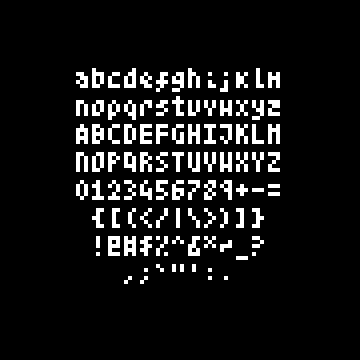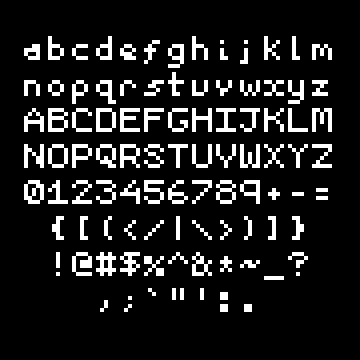A family of small, fast, and simple bitmap fonts in single-file C headers
These are not intended as a replacement for fancy user fonts. I see them being useful for quickly getting up debug text on a PC without having to link an external font file, or for embedded developers with limited memory.
Replace the prefix if using a different font.
/* Draw strings into a pixel buffer. Overwrites any pixels drawn to (no alpha). */
/* returns number of lines printed */
int blit16_TextNExplicit(unsigned int *Buffer, unsigned int Value, int Scale,
int BufWidth, int BufHeight, int Wrap,
int StartX, int StartY, int StrLen, char *String)
/* Buffer - the array of pixels that you're drawing into.
* Value - text colour value, uint by default, but can be changed as shown below.
* Should work for most representations.
* Scale - simple integer scaling of glyph 'pixels' to buffer pixels.
* e.g. a value of 3 would draw a 3x3 square for each 'pixel'.
* BufWidth, BufHeight - width and height of the buffer being drawn into.
* Wrap - controls what happens when the text reaches the edge of the buffer.
* blit_Clip (0) stops printing, blit_Wrap continues on the next line.
* Wrapping is only done per character, not per word.
* StartX, StartY - x and y in the buffer for the top-left of the glyph's bounding box.
* StrLen - maximum length of string from pointer if '\0' is not hit first.
* If negative, will just run to the first null terminator.
* String - the text you want to draw on the screen.
*/
/* The same as above, but no need to specify negative StrLen */
blit16_TextExplicit(unsigned int *Buffer, unsigned int Value, int Scale,
int BufWidth, int BufHeight, int Wrap,
int StartX, int StartY, char *String)
/* Use a blit_props struct to keep the infrequently changing elements together */
blit16_TextNProps(blit_props Props, int StartX, int StartY, int StrLen, char *String)
blit16_TextProps(blit_props Props, int StartX, int StartY, char *String)
/* Use the properties in the global font */
blit16_TextN(int StartX, int StartY, int StrLen, char *String)
blit16_Text(int StartX, int StartY, char *String)
/* Scale the font metrics pointed to in the font */
void blit16_Scale(blit16_font *Font, int Scale)
/* Convert between ASCII code (or character literals) and the associated glyph index. */
blit_IndexFromASCII(unsigned int ascii);
blit_ASCIIFromIndex(unsigned int index); /* (all dimensions in glyph pixels) */
blit16_WIDTH /* Width of glyphs */
blit16_HEIGHT /* Height of glyphs (excluding descender) */
blit16_ADVANCE /* Distance between start of 1 character and the next */
blit16_DESCENDER /* Maximum distance of descenders below baseline */
blit16_BASELINE_OFFSET /* Distance between baseline and top of next character */
blit16_ROW_ADVANCE /* Distance between baseline of 1 row and the next */typedef unsigned short blit16_glyph;
/* Keep infrequently changing properties together, see above for explanations */
typedef struct blit_props
{
unsigned int *Buffer; /* changeable to a custom pixel type */
unsigned int Value; /* ... see the compile-time options */
int Scale;
int BufWidth;
int BufHeight;
enum {blit_Clip, blit_Wrap} Wrap;
} blit_props;
/* This is just a convenience wrapper around the array:
* - simplify calls even more
* - reference the constants in a debugger
* - keep scaled versions of the constants above
*/
typedef struct blit16_font
{
const blit16_glyph Glyphs[blit_NUM_GLYPHS];
const unsigned int Width;
const unsigned int Height;
const unsigned int Descender;
const unsigned int Advance;
const unsigned int RowAdvance;
blit_props Props;
} blit16_font;/* Contains the main font data.
* Set the Props for this to use the blit16_Text[N] functions, and
* (optionally) use blit16_Scale on it to keep the metrics up to date.
*/
blit16_font Blit16/* determines the pixel type that blit draws (defaults to unsigned int) */
#define blit_pixel your_pixel_type_here
/* removes the inline qualifier from all functions */
#define blit_NO_INLINE
/* replaces all inline functions with macro equivalents */
#define blit16_MACRO_INLINE
/* removes blit16_font, blit16_Scale, and replaces Blit16 with blit16_Glyphs */
#define blit16_ARRAY_ONLY
/* removes all string functions except blit16_StringNExplicit */
#define blit16_NO_HELPERS- Draw the bitmap for a glyph in your text editor, using characters that represent pixels being on ('#'), or off (' '). (You can better see what the end result will be with a square font)
/* ASCII: 49, Char: '1', Name: One */
char Glyph_One[] =
/* 012 */
/* 0 */ " # "
/* 1 */ "## "
/* 2 */ " # "
/* 3 */ " # "
/* 4 */ "###";- This is treated by C as a single linear string...
" # ## # # ###"...which can be easily translated to bits by treating spaces as 0s and #s as 1s. (This is reversed because processing it is slightly more convenient that way round.)
111010010011010- This can then be represented as a number (in hexadecimal).
0x749a(One happy coincidence of this format is that space is represented by the number 0)
- Collect a lot of these into an array, sorted in the ASCII code order (omitting the non-printable characters, starting with space at ASCII code 32).
typedef unsigned short blit16_glyph;
blit16_glyph blit16_Glyphs[95] = {
0x0000,0x2092,0x002d,0x5f7d,0x279e,0x52a5,0x7ad6,0x0012,
0x4494,0x1491,0x017a,0x05d0,0x1400,0x01c0,0x0400,0x12a4,
0x2b6a,0x749a,0x752a,0x38a3,0x4f4a,0x38cf,0x3bce,0x12a7,
0x3aae,0x49ae,0x0410,0x1410,0x4454,0x0e38,0x1511,0x10e3,
0x73ee,0x5f7a,0x3beb,0x624e,0x3b6b,0x73cf,0x13cf,0x6b4e,
0x5bed,0x7497,0x2b27,0x5add,0x7249,0x5b7d,0x5b6b,0x3b6e,
0x12eb,0x4f6b,0x5aeb,0x388e,0x2497,0x6b6d,0x256d,0x5f6d,
0x5aad,0x24ad,0x72a7,0x6496,0x4889,0x3493,0x002a,0xf000,
0x0011,0x6b98,0x3b79,0x7270,0x7b74,0x6750,0x95d6,0xb9ee,
0x5b59,0x6410,0xb482,0x56e8,0x6492,0x5be8,0x5b58,0x3b70,
0x976a,0xcd6a,0x1370,0x38f0,0x64ba,0x3b68,0x2568,0x5f68,
0x54a8,0xb9ad,0x73b8,0x64d6,0x2492,0x3593,0x03e0,
};- TADAA! We have a font.
- Extra fanciness - eagle-eyed readers may have noticed that I'm only using 15 of the 16 available bytes in the example.
The 16th is set as a flag for shifting the character's pixel grid down, to allow for descenders without a larger glyph type size.
Depending on the glyph type and aspect ratio, there may be no space for such a flag, or for multiple (e.g. 0-3 descender levels for a 32-bit glyph:
(5 * 6) % 32 == 2; 1 << 2 == 4;)
- sweet (my single-header C test suite)
- live_edit (my single-header C library-loading/tweaking/debugging/profiling tools)
- STB libraries (lots of excellent single-header libraries, including
stb_truetype.hfor when you want proper fonts) - tigr (multiplatform 'Tiny Graphics' header. Easy to set up. Plays nicely with blit fonts.)
ISC License
Copyright (c) 2018 Andrew Reece
Permission to use, copy, modify, and/or distribute this software for any
purpose with or without fee is hereby granted, provided that the above
copyright notice and this permission notice appear in all copies.
THE SOFTWARE IS PROVIDED "AS IS" AND THE AUTHOR DISCLAIMS ALL WARRANTIES
WITH REGARD TO THIS SOFTWARE INCLUDING ALL IMPLIED WARRANTIES OF
MERCHANTABILITY AND FITNESS. IN NO EVENT SHALL THE AUTHOR BE LIABLE FOR
ANY SPECIAL, DIRECT, INDIRECT, OR CONSEQUENTIAL DAMAGES OR ANY DAMAGES
WHATSOEVER RESULTING FROM LOSS OF USE, DATA OR PROFITS, WHETHER IN AN
ACTION OF CONTRACT, NEGLIGENCE OR OTHER TORTIOUS ACTION, ARISING OUT OF
OR IN CONNECTION WITH THE USE OR PERFORMANCE OF THIS SOFTWARE.
If this license is not suitable for your circumstances, please let me know and I'll see what I can do to make it work for you.

